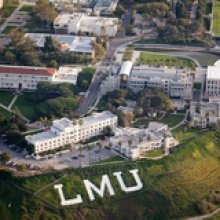A Report from SEMSCHC 2012

This past weekend (Feb. 25, 2012) saw another enjoyable annual conference of the Southern California and Hawai’i Chapter of the Society for Ethnomusicology (SEMSCHC). This region—whose acronym the UC Riverside students have taken to pronouncing as “some such”—has seen increasing attendance in the past few years. Unfortunately, it still struggles with representation from its Hawai’i contingent as a result of the insurmountable cost for those graduate students needing to traverse the Pacific. Nevertheless, the conference was intellectually stimulating, socially convivial, and fairly well organized on the pleasant campus of Loyola Marymount University (LMU). Indeed, SEMSCHC conferences are always a good reason to explore SoCal campuses one might not otherwise have a chance to visit. In that respect, LMU was exceptional as it can boast one of the most spectacular views in all of Los Angeles County, situated atop a bluff overlooking the ocean, the Santa Monica Mountains, downtown LA, and everything in between.
This year’s conference program was shorter than usual as this was the first time the conference was limited to just one day. The chapter seems split over whether or not this is ideal. Two days may be more difficult if traveling far distances, and inevitably means many people will attend only one day, but there also may be something to be said for a second day once one has “gotten the hang” of a particular location. Furthermore, some students apparently were unable to get reimbursed for travel to the conference—even when giving a presentation—since a one-day conference did not sound sufficiently “serious” for some bureaucrats in charge of reimbursements. While economic realities of the chapter and host institutions might sometimes require one-day programs in the future, they could potentially always feel incomplete, as many people are used to referring to the event as the SEMSCHC “weekend.” Still, the papers were enjoyable and demonstrated the great variety of work being done at the region’s campuses.

View from LMU campus. (This photo and frontispiece courtesy Loyola Marymount University)
Two items in the program are especially salient: the panel on archiving led by Anthony Seeger (UCLA) and the keynote address by Dick Hebdige (UCSB).
Seeger’s panel (entitled “For Better Ethnomusicology and a Better World, Archive It!”) had a surprising number of presenters (nine), each with approximately 10 minutes to present. While this panel attempted to cover a wide swath of archiving topics, the large number of presenters may have diminished its usefulness for those looking for more practical considerations when conducting and designing fieldwork. It seems that archivists feel the need to explain themselves and their usefulness to today’s ethnomusicologists. Perhaps their value is questioned in some circles, but it seems most ethnomusicologists would agree they are useful, and very much so. What we perhaps need more than preaching to the choir would be practical considerations, from the archivists themselves, in regards to preparing archive-worthy materials before entering the field. This might have been especially useful for those students who don’t have the advantage of being on a campus with an ethnomusicology archive (i.e., most of them). Still, it was nice to be reminded by the panelists (from first-year grad students to some of the biggest names in the field) that archiving and archives may be one of the most important aspects of ethnomusicology for its relevance beyond academia itself.

L-R: Robert Garfias (UC Irvine), Anthony Seeger (UCLA), and Aaron Bittel (UCLA Ethnomusicology Archive)
Another noteworthy item in the program was Dick Hebdige’s talk titled “Becoming Animal: Race, Terror, and the American Roots.” The program portrayed it as:
A journey across the mid 20th century remnants of the ‘old weird America’ (Greil Marcus) with reference to contemporary music recordings, films, TV programs and U.S. popular culture. Is it possible to hear in the mid-1950’s shift in Southern US roots musics (country, R&B, rockabilly) from barnyard livestock to jungle beast impersonations a pre-figuration of the coming conflict over Civil Rights and desegregation in the American South?
Unfortunately, this tidy description and introduction wasn’t heard in the presentation itself. The “pre-figuration” of Civil Rights conflict was not clearly outlined (at least in this version of the presentation), but it was clear that Hebdige was interpreting or suggesting a lurking pop-culture fear of animality at the intersection of racial others and the rural white underclass. What he lacked in clarity of argument, he made up for in performance. And how! Hebdige drew the audience in by being part scholar, part button-pushing DJ, a white-t-shirt-wearing lanky mass of frenetic intellectual energy. His writing, at times poetic and often dazzling, was cut into and mixed with audio examples (on cassette!) and video clips of everything from charismatic Baptist services to Deliverance. Such a display was perhaps not surprising from someone whose research interests include “transmedia performance,” but the very experience of it was enjoyable, something not always the case with academic conference papers. In the end, one might have been left wondering to what extent Hebdige’s interpretive discourse created its own subject, but it certainly provided a lot of food for thought.
The long conference day ended with a performance by two Balinese gamelan ensembles, a student ensemble from LMU and a more seasoned group from Berkeley, CA. Congratulations to all those involved in this year’s conference! Here’s looking forward to next year at UC Riverside!





